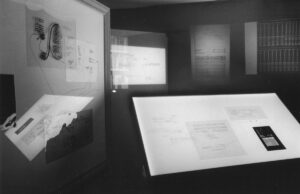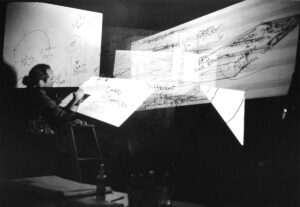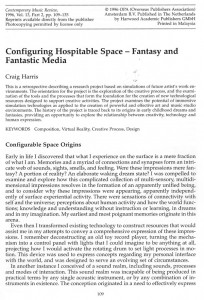
In 1987 Artistic Director Craig Harris launched a long term research and design project entitled Configurable Space, exploring future creative work environments, the creative process and the use of new technological resources to support artistic functions. The fundamental premise hypothesizes that it is possible to develop integrated, technological resources that encompass the breadth of our beings in all of its complexity.
These comprehensive resources would allow us to deepen our understanding of ourselves, and to communicate on these deeper levels in a conscious and purposeful manner.
Configurable Space is directed towards the development of a balanced understanding about how we use the visual, aural, tactile, and configurable capabilities of digital technologies, and how the tools developed affect ways that we think, feel, formulate, and develop on intellectual, spiritual, and emotional planes. It is built upon the simulation of future creative environments using any available technology that could be used to support the illusion that the implied resources already exist. The simulations incorporate representations of interactive computer display tables, walls, and holographic images, within a multi-dimensional sound environment. This creates the context for exploring relevant issues and for imagining how the space might be used in actual circumstances. The simulations represent ongoing research and artistic explorations, probing the creative process, and the relationship between artists and new technologies. In Configurable Space the artist dynamically constructs the total environment and the creative tools to suit specific requirements.
In addition to advancing the understanding of our use of new technologies in a variety of human endeavors, the goal of this initiative was to influence the development of technological resources, and to interfere with a development trend that reinforced limited perspectives of how we use these tools. Configurable Space research has been presented in a variety of forms – in traditional hard copy and electronic books and journals (International Computer Music Conference Proceedings, Companion to Contemporary Musical Thought, Contemporary Music Review, Leonardo Electronic Almanac), and in hybrid performance presentations at international conferences, universities and corporate research facilities (International Computer Music Conferences, International Symposium on Electronic Arts, Xerox Palo Alto Research Center, Yamaha Music Technologies, Alias Research Strategic Research Group).
Artistic Necessity – Context Orientation – Configurable Space
 Companion to Contemporary Musical Thought
Companion to Contemporary Musical Thought
Edited by John Paynter, Tim Howell, Richard Orton
and Peter Seymour
Published by Routledge in 1992
The chapter Artistic Necessity – Context Orientation – Configurable Space, published in the Companion to Contemporary Musical Thought, was the first article to appear documenting the Configurable Space research initiative, a long term research and design project exploring the creative process and the use of new technological resources to support artistic functions.
The Configurable Space design methodology is based on the creation of models that simulate the functioning and usage of hypothetical systems. This method allows for modeling without the limitations imposed by considerations for specific implementation details, and carries the significance of being able to address ideal states. The goal is to provide paradigms to guide long term development, a goal that is particularly essential in considering virtual reality or immersive simulation technologies, given the fact that the computer resources available today are so constrained relative to the hypothetical systems they are designed to emulate. Liberation from implementation considerations paves the way towards a clarity in conceptual design. Issues relating to the use or non-use of head or hand gear, or even physical versus virtual input/output devices, becomes a question of personal preference and contextual requisites, rather than a technological necessity.
Read the full chapter here:
Artistic Necessity, Context Orientation, Configurable Space
Configuring Hospitable Space – Fantasy and Fantastic Media
Contemporary Music Review, Volume 13 Part 2
Issue Editor: Craig Harris
Published by Harwood Academic Publishers in 1996
The chapter Configuring Hospitable Space – Fantasy and Fantastic Media, published in an issue of Contemporary Music Review edited by the author, continues the process of documenting the Configurable Space research and design project launched in the mid-1980s. This version of the project provides a retrospective describing this research project based on simulations of future artist’s work environments.
The orientation for the project is the exploration of the creative process, and the examination of the tools and the processes that form the foundation for the creation of new technological resources designed to support creative activities. The project examines the potential of immersive simulation technologies as applied to the creation of powerful and effective art and music studio environments. The history of the project is traced back to its origins in early childhood dreams and fantasies, providing an opportunity to explore the relationship between creativity, technology and human expression.
San Francisco-based photographer Marion Gray took over five hundred photographs during multiple sessions working in the constructed environment, using sketches on transparencies, colored gels, slide projections, and live drawing. These images capture various perspectives of room views and close images, documenting the sketching and representation process, the evolving environmental characteristics and the resource requirements during the evolution of a music composition. The composition was based on the creation and expression of the sonic world described above. The original installation was constructed primarily for the purpose of creating the initial collection of slides and photographs, and not as a public art installation. The creative context emulates a non-real time studio shooting process, resembling a procedure which one would go through to create a series of animated sequences of visual material.
The envisioned technology supports the following resources and ideals:
- Large integrated and interactive display tables and walls; dynamically sizable interactive projected images.
- Multidimensional and multi-channel sound capability, with simultaneous record and playback facilities, and real-time digital mixing and processing.
- Comprehensive and integrated resources supporting transparent, translucent and opaque overlay and mixture of visual elements on any surface.
- Touch- and sound-sensitive surfaces, space and control devices, incorporating any images and sounds, or any combinations of images and sounds imaginable. Size, shape, sound, spatial characteristics, and styles of interaction are all elements that coincide directly with creative intent and personal style.
- Dynamic configuration of all resources with any kind of visual and audio templates for creating and performing in the environment.
- Direct control of the total environment, following the natural flow of an individual’s creative energy. This is in contrast to resources that force one to work with resources that contain preconceived notions about what art is, or how the human process is supposed to work.
- Elaborate history tracking, analysis and presentation resources.
Read the full article here:
Configuring Hospitable Space – Fantasy and Fantastic Media
Configurable Space VII: a hybrid performance-presentation

Configurable Space VII was a hybrid performance-presentation sponsored by Yamaha Music Technologies in Marin, California, in May of 1990. The purpose was to demonstrate the underlying concepts of Configurable Space in a context permitting experimentation with multimedia communication resources.
The event space, appropriately located in an office presentation space intended for corporate communication, was built around a large, white wall. Three slide projectors were positioned carefully with respect to image size, angle, and proximity. A multi-layered sound environment included original music, prerecorded music from different cultures and styles, and prepared soundfiles of sampled and processed sound, all placed in a variety of simulated room environments. Sound from each of the microphones was processed to create a different ambiance, reinforcing different styles of communication. I used one, the evocation of a large room with a distant dreamy character, for story-telling and indirect communications and the other, which evoked a smaller, less-reverberant environment, for declamatory and direct communication techniques.
The work consisted of two movements. Each movement was weighted differently with respect to direct, linear presentation techniques, and indirect, non-linear modes of communication. Each movement consisted of a different balance between specific, timed accompaniment, quasi-random selection from sets of elements, and extemporaneous selection from a wide variety of sonic and visual material.
Score directions utilizing a 3-dimensional score notation were provided for live presentation assistants to perform the visual and aural components. During the event, I wrote and drew over the surface of the wall, selecting multicolored marking pens of different thicknesses, with attention towards the functional use of color, shapes and multi-dimensional containers. Writing and drawing on the wall reinforced main points, summarized internal sections within the presentation, followed tangential thoughts, and drew links between graphic and textual material written and projected. The performer of the visual component controlled slide carousel position and light intensity for three slide projectors, and also controlled the video projector. The performer of the audio component incorporated twenty channels of sound, including pre-recorded tapes and CDs, live performed sounds from the computer, live-processing of sound, two microphones, and an antique Victrola. Performers responded to what was seen, heard, and felt. Images changed and modulated in light intensities, blending, highlighting, and contrasting with the drawing on the wall. In this context I track the creative process, examining tasks and the tools designed to address several circumstances. The total environment was considered in relation to its impact on creative activities, and I explored communication on many levels.
Configurable Space VII was directed towards advancing the following goals and research interests:
- Experiment with aspects of presentation and performance that were predefined and non-changeable in previous manifestations, and work with live configuration of materials.
- Examine technological resources which would be required to support the live event in a more interactive, multimedia environment
- Examine expressive power and effect of live drawing onto the white board while images were projected and changing.
- Expand the live commentary/presentation aspects to make use of audio support for different types of message passing.
